Abstract
3-Decynoyl-N-acetylcystamine is known to inhibit the in vitro growth of Escherichia coli but not of yeasts or mammalian cells. Neither the free acid nor the 2 positional isomer is active (L. R. Kass, J. Biol. Chem. 243:3223-3228, 1968). Other studies have shown that 2-hexadecynoic acid is fungitoxic whereas most of the shorter chain isomers are inactive (H. Gershon and L. Shanks, Can J. Microbiol. 24:591-597, 1978). Since these studies suggested that positional or chain length isomers of the acetylenic acids may selectively inhibit the growth of microorganisms, the effect of the alkynoic acids on the in vitro growth of gram-positive and gram-negative bacteria was evaluated. 2-Hexadecynoic acid was found to be the most active species. This acid was bacteriostatic for all gram-positive bacteria tested. The acid was readily taken up by the treated cells and incorporated into the phospholipid fraction. When added to the culture medium, 2-hexadecynoic acid inhibited the growth of HeLa cells, but when mixed with an equivalent amount of palmitic acid, growth inhibition was not observed.
Full text
PDF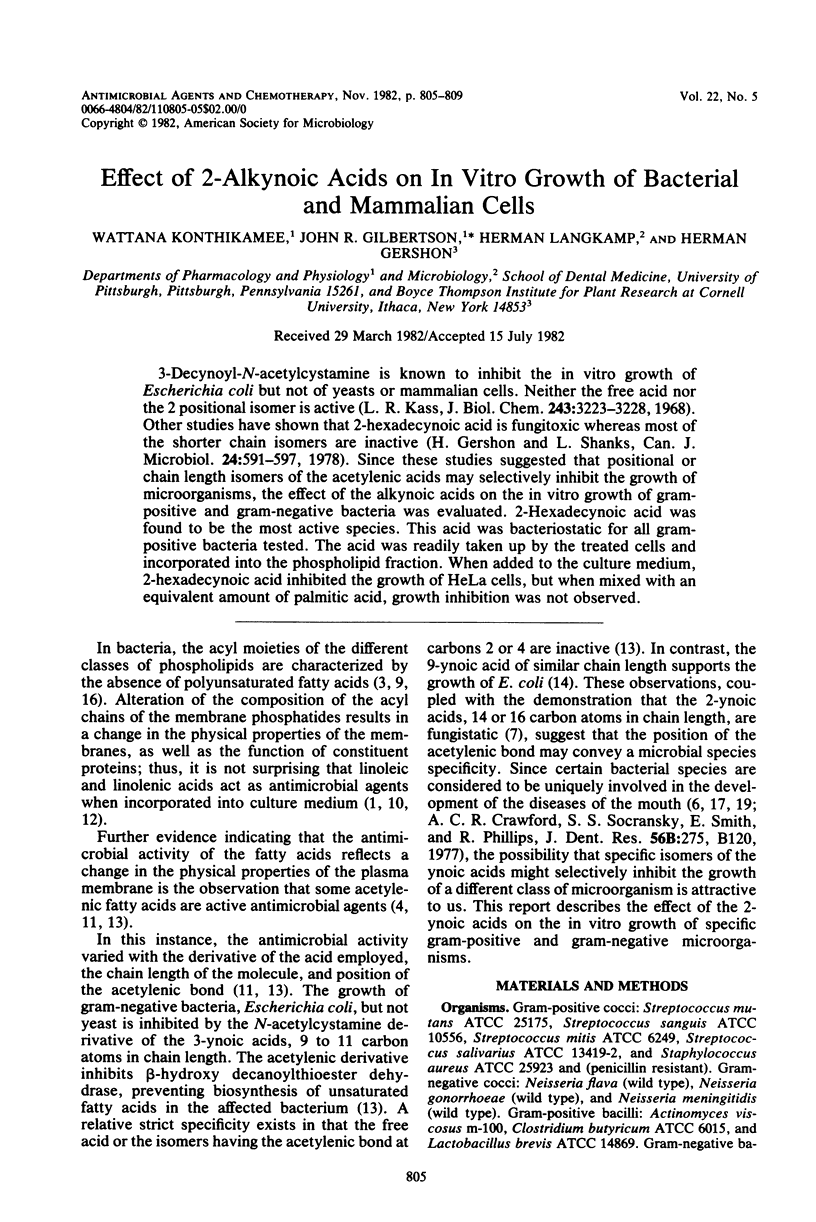
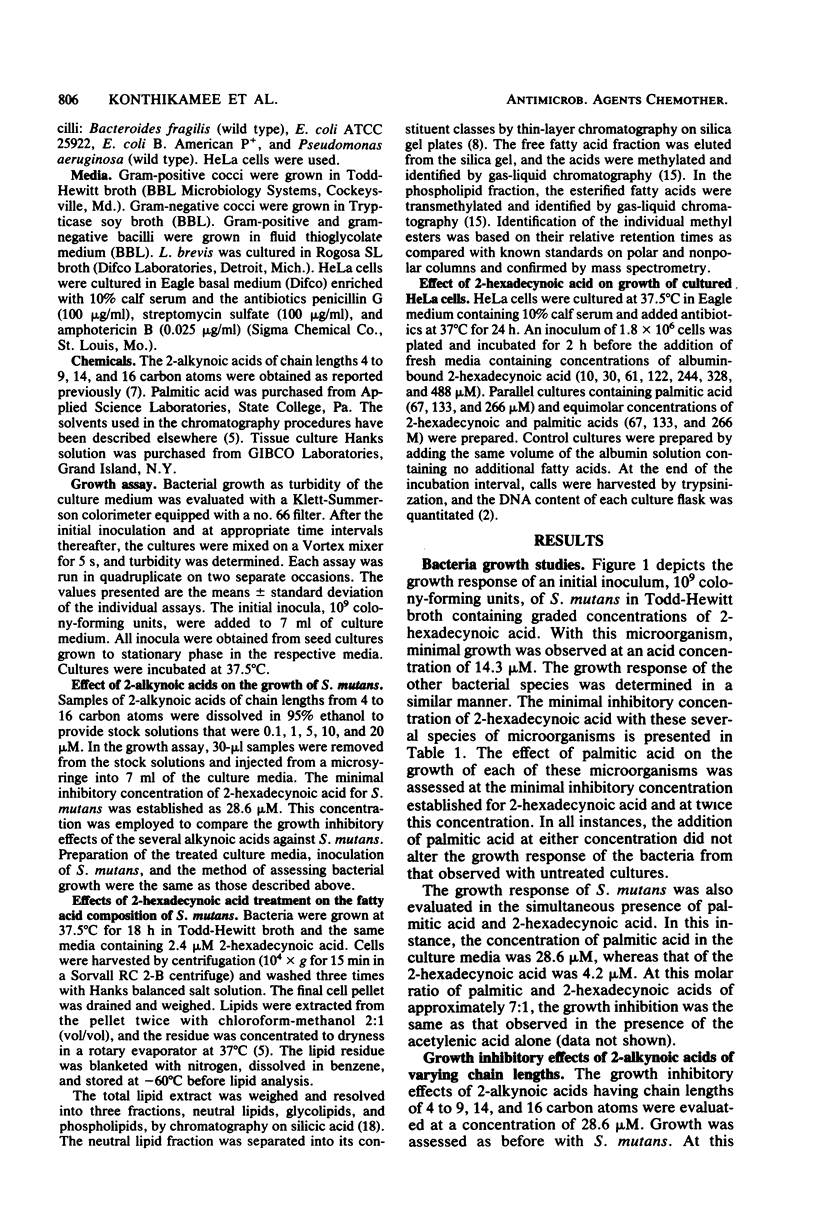
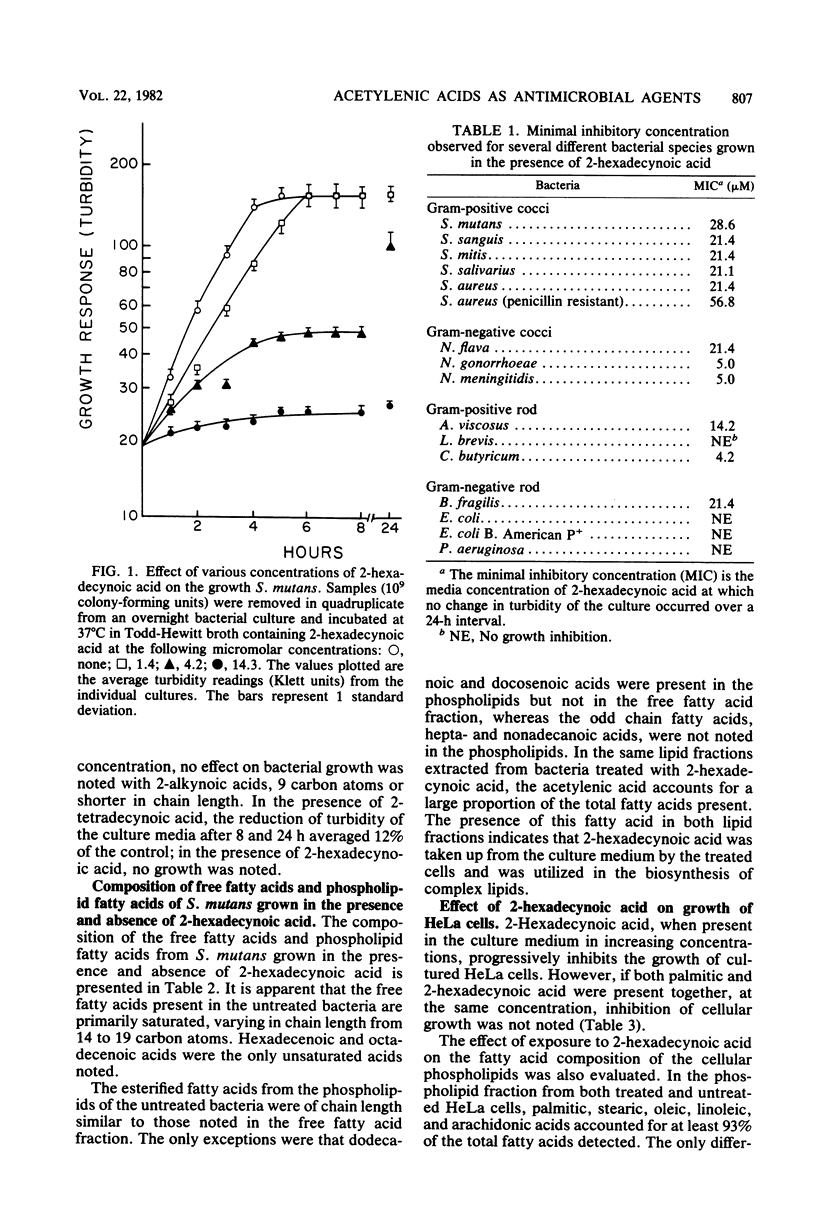
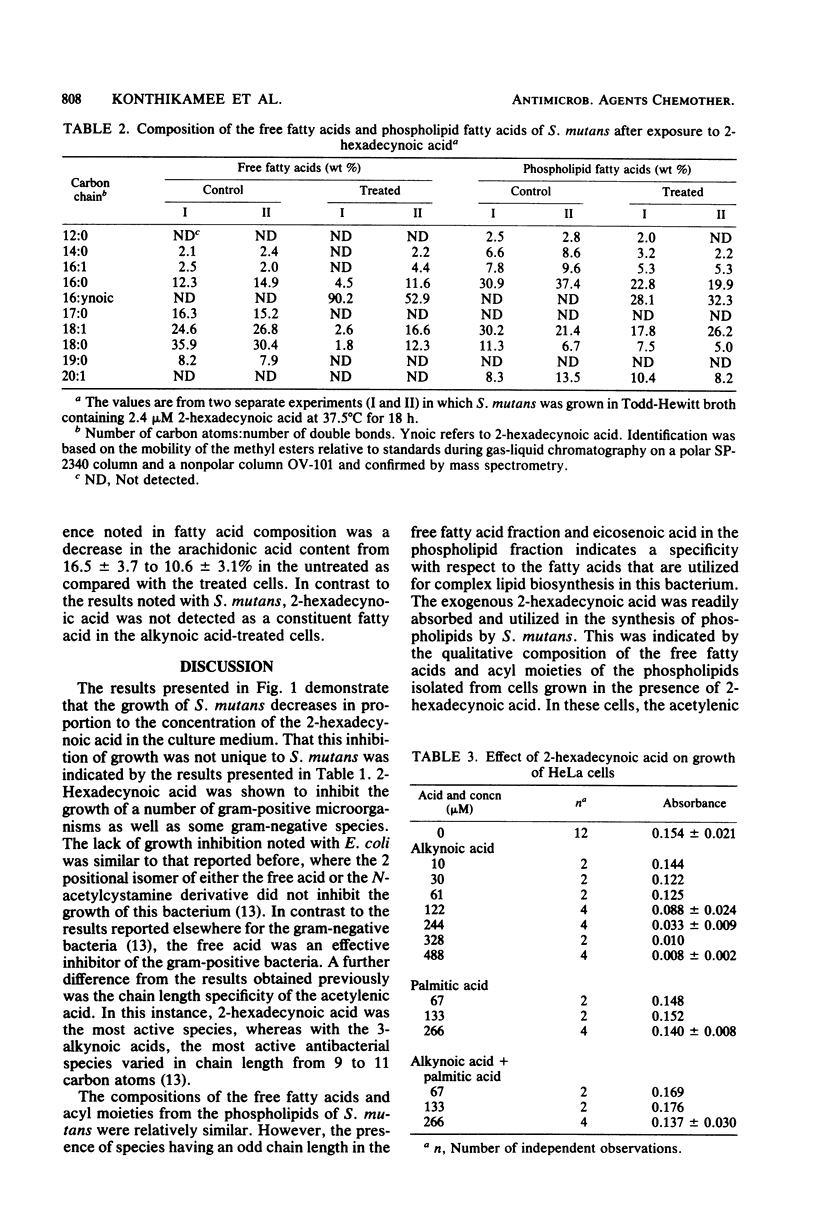
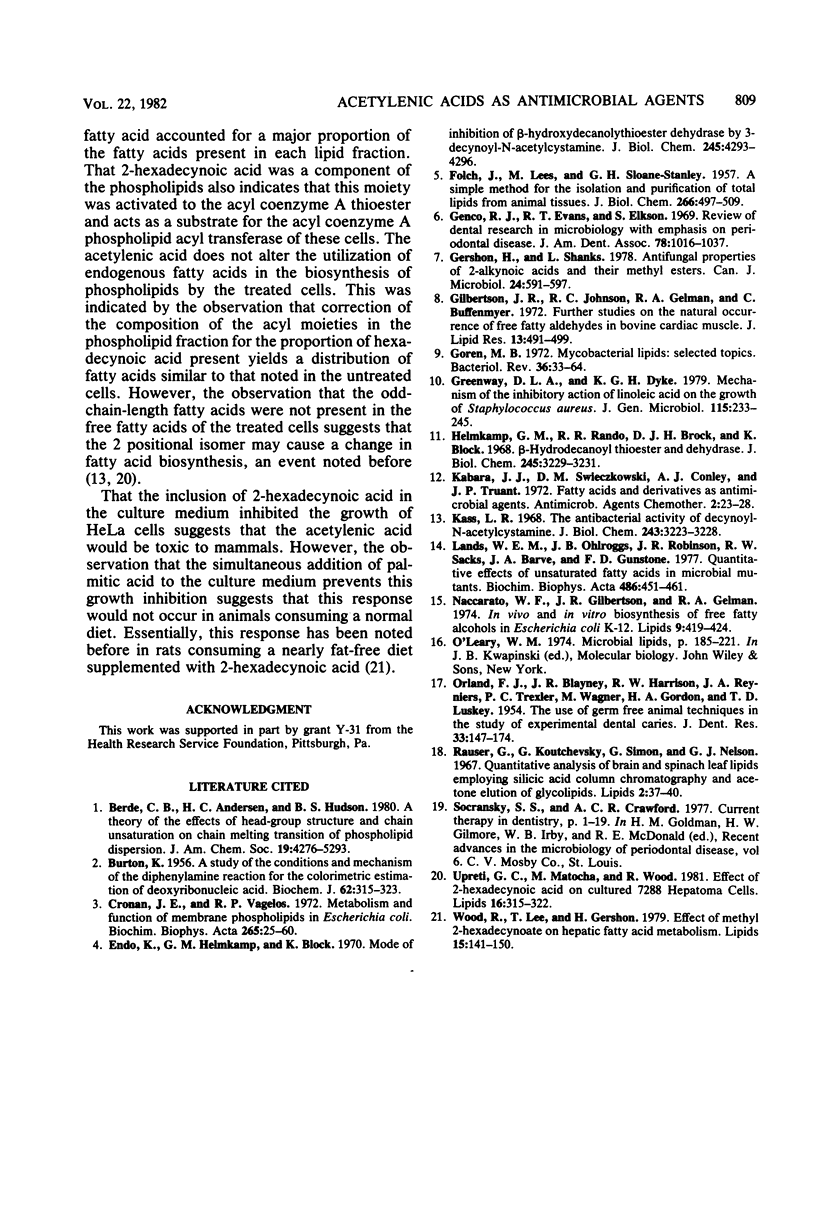
Selected References
These references are in PubMed. This may not be the complete list of references from this article.
- BURTON K. A study of the conditions and mechanism of the diphenylamine reaction for the colorimetric estimation of deoxyribonucleic acid. Biochem J. 1956 Feb;62(2):315–323. doi: 10.1042/bj0620315. [DOI] [PMC free article] [PubMed] [Google Scholar]
- Cronan J. E., Vagelos P. R. Metabolism and function of the membrane phospholipids of Escherichia coli. Biochim Biophys Acta. 1972 Feb 14;265(1):25–60. doi: 10.1016/0304-4157(72)90018-4. [DOI] [PubMed] [Google Scholar]
- Endo K., Helmkamp G. M., Jr, Bloch K. Mode of inhibition of beta-hydroxydecanoyl thioester dehydrase by 3-decynoyl-N-acetylcysteamine. J Biol Chem. 1970 Sep 10;245(17):4293–4296. [PubMed] [Google Scholar]
- FOLCH J., LEES M., SLOANE STANLEY G. H. A simple method for the isolation and purification of total lipides from animal tissues. J Biol Chem. 1957 May;226(1):497–509. [PubMed] [Google Scholar]
- Genco R. J., Evans R. T., Ellison S. A. Dental research in microbiology with emphasis on periodontal disease. J Am Dent Assoc. 1969 May;78(5):1016–1036. doi: 10.14219/jada.archive.1969.0162. [DOI] [PubMed] [Google Scholar]
- Gershon H., Shanks L. Antifungal properties of 2-alkynoic acids and their methyl esters. Can J Microbiol. 1978 May;24(5):593–597. doi: 10.1139/m78-096. [DOI] [PubMed] [Google Scholar]
- Gilbertson J. R., Johnson R. C., Gelman R. A., Buffenmyer C. Natural occurrence of free fatty aldehydes in bovine cardiac muscle. J Lipid Res. 1972 Jul;13(4):491–499. [PubMed] [Google Scholar]
- Goren M. B. Mycobacterial lipids: selected topics. Bacteriol Rev. 1972 Mar;36(1):33–64. doi: 10.1128/br.36.1.33-64.1972. [DOI] [PMC free article] [PubMed] [Google Scholar]
- Greenway D. L., Dyke K. G. Mechanism of the inhibitory action of linoleic acid on the growth of Staphylococcus aureus. J Gen Microbiol. 1979 Nov;115(1):233–245. doi: 10.1099/00221287-115-1-233. [DOI] [PubMed] [Google Scholar]
- Helmkamp G. M., Jr, Brock D. J., Bloch K. Beta-hydroxydecanoly thioester dehydrase. Specificity of substrates and acetylenic inhibitors. J Biol Chem. 1968 Jun 25;243(12):3229–3231. [PubMed] [Google Scholar]
- Kabara J. J., Swieczkowski D. M., Conley A. J., Truant J. P. Fatty acids and derivatives as antimicrobial agents. Antimicrob Agents Chemother. 1972 Jul;2(1):23–28. doi: 10.1128/aac.2.1.23. [DOI] [PMC free article] [PubMed] [Google Scholar]
- Kass L. R. The antibacterial activity of 3-decynoyl-n-acetylcysteamine. Inhibition in vivo of beta-hydroxydecanoyl thioester dehydrase. J Biol Chem. 1968 Jun 25;243(12):3223–3228. [PubMed] [Google Scholar]
- Lands W. E., Ohlrogge J. B., Robinson J. R., Sacks R. W., Barve J. A., Gunstone F. D. Quantitative effects of unsaturated fatty acids in microbial mutants. VII. Influence of the acetylenic bond location on the effectiveness of acyl chains. Biochim Biophys Acta. 1977 Mar 25;486(3):451–461. doi: 10.1016/0005-2760(77)90095-9. [DOI] [PubMed] [Google Scholar]
- Naccarato W. F., Gilbertson J. R., Gelman R. A. In vivo and in vitro biosynthesis of free fatty alcohols in Escherichia coli K-12. Lipids. 1974 Jun;9(6):419–428. doi: 10.1007/BF02532060. [DOI] [PubMed] [Google Scholar]
- ORLAND F. J., BLAYNEY J. R., HARRISON R. W., REYNIERS J. A., TREXLER P. C., WAGNER M., GORDON H. A., LUCKEY T. D. Use of the germfree animal technic in the study of experimental dental caries. I. Basic observations on rats reared free of all microorganisms. J Dent Res. 1954 Apr;33(2):147–174. doi: 10.1177/00220345540330020201. [DOI] [PubMed] [Google Scholar]
- Rouser G., Kritchevsky G., Simon G., Nelson G. J. Quantitative analysis of brain and spinach leaf lipids employing silicic acid column chromatography and acetone for elution of glycolipids. Lipids. 1967 Jan;2(1):37–40. doi: 10.1007/BF02531998. [DOI] [PubMed] [Google Scholar]
- Upreti G. C., Matocha M., Wood R. Effect of 2-hexadecynoic acid on cultured 7288C hepatoma cells. Lipids. 1981 May;16(5):315–322. doi: 10.1007/BF02534955. [DOI] [PubMed] [Google Scholar]


